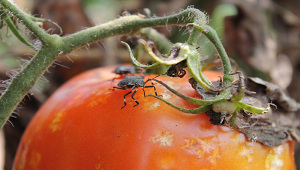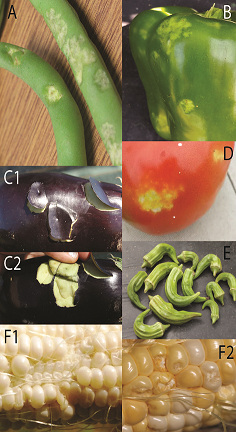|
Post by: Thomas Pike and Ryan Gott Farm Field-Scale Tracking of BMSB: The Crop Circle of Life The brown marmorated stink bug (BMSB) (Figure 1) is an extremely destructive invasive pest that has wreaked havoc in crops and landscapes for over a decade. With over 170 different host plants, BMSB seems perfectly willing to exploit any of a number of different resources to survive. However, does it use all of these equally? Our speaker (and recent M.S. graduate) Emily Zobel asked this very question. She, along with faculty members Galen Dively and Cerruti Hooks, sought to determine which vegetables would be most attractive to BMSB at different times in the growing season. Emily planted several common vegetables (green beans, okra, eggplant, bell pepper, tomato and sweet corn) and looked for stink bugs and their feeding damage on the plants to determine which plants were most attractive at what time (Figure 2). She found that okra, bell peppers and sweet corn proved exceptionally popular for the stink bugs, with extraordinarily high numbers found on okra, while green beans, eggplant and tomatoes lagged significantly further behind in the preference race. However, when looking at fruit loss due to stink bug injury, the pattern is markedly different. Despite seeing the lowest numbers of stink bugs during the season, tomato damage was disproportionately high, with just over a third of the harvested tomatoes showing damage. Meanwhile, okra, despite harboring the overwhelming majority of stink bugs, lost a mere 20% of its fruit to stink bug damage. Of particular note in Emily’s research is the distinct lack of native stink bugs, such as the harlequin bug and the spined soldier bug, in the counts on plants. Despite noting that the rise of stink bugs in general is likely due to a reduction in the use of broad-spectrum insecticides, it seems that BMSB is the only beneficiary, with native stink bugs making up a measly 1% of the total stink bugs counted. Emily’s results have implications for scouting and managing BMSB. Better timing of scouting and application of control measures depends on the specific crop combinations being grown on a given farm. Particularly interesting is the strong attraction of BMSB to okra, showing it as a potential trap crop. About Thomas Pike and Ryan Gott:
Thomas Pike is a third year Masters student in Paula Shrewsbury's lab conducting research on ornamental IPM. His primary research focus is on the effects of entomopathogenic fungi on the brown marmorated stink bug and their potential as a biological control. Ryan Gott is a PhD student in the lab of Bill Lamp. Ryan studies environmental toxicology and environmental risk assessment with a focus on developing biomarkers for chemicals that interact with ABC transporters. Comments are closed.
|
Categories
All
Archives
June 2024
|
Department of Entomology
University of Maryland
4112 Plant Sciences Building
College Park, MD 20742-4454
USA
Telephone: 301.405.3911
Fax: 301.314.9290
University of Maryland
4112 Plant Sciences Building
College Park, MD 20742-4454
USA
Telephone: 301.405.3911
Fax: 301.314.9290



 RSS Feed
RSS Feed




